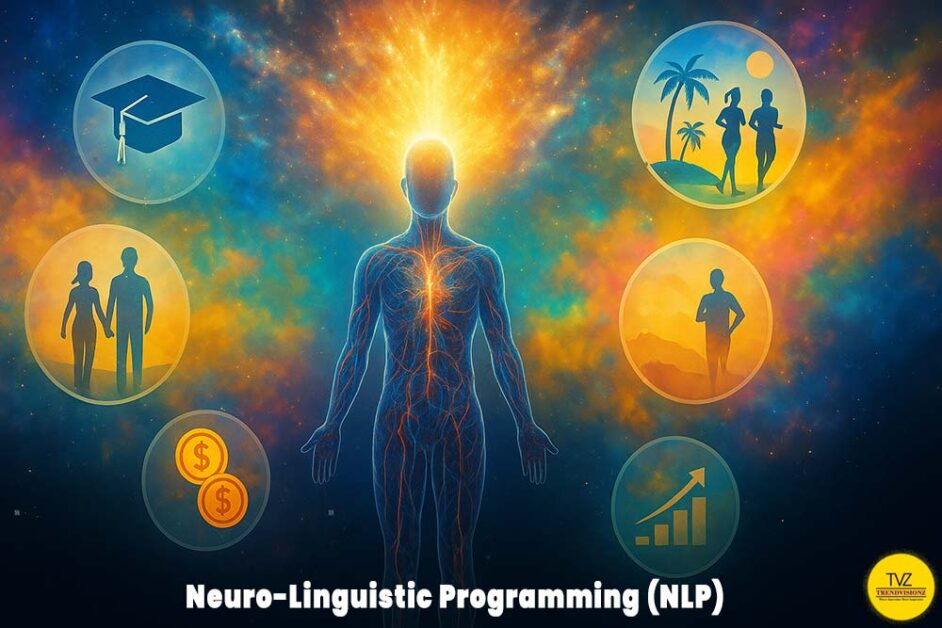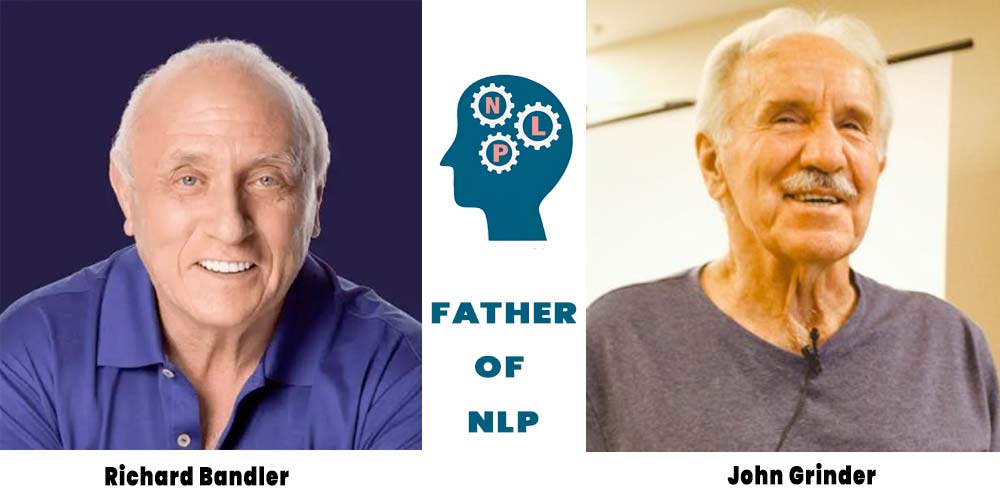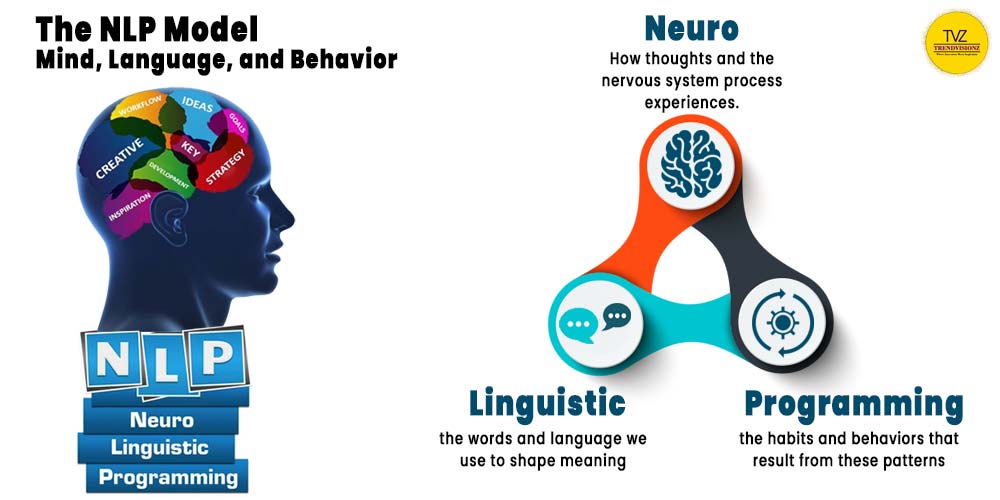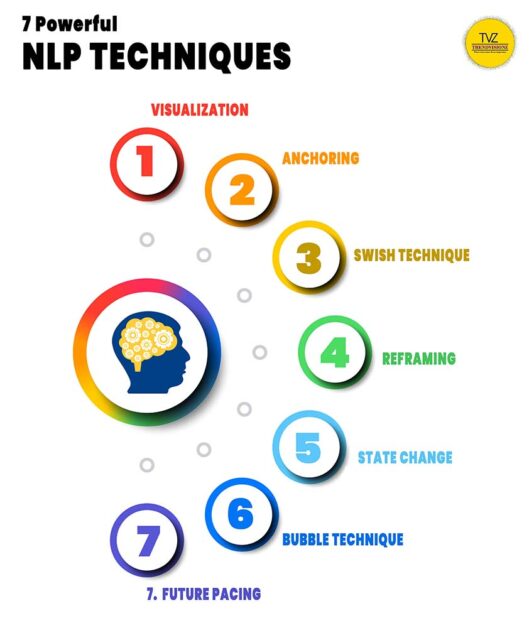You’re standing backstage, seconds before a big presentation. Your palms are sweaty, your heart is racing, and doubts creep in. I know that moment well. Before every major presentation or training, I feel the same goosebumps. But instead of letting fear take over, I rely on a simple NLP anchor — one breath, one gesture, and calmness flows back. Research shows nearly 77% of professionals experience performance anxiety (glassophobia) before public speaking, yet with the right mental tools, that fear can be transformed into clarity and confidence.

As an ACC coach and NLP practitioner, I’ve seen these techniques work everywhere — in corporate trainings, during free NLP sessions with my direct-selling teams, and in one-on-one coaching with mentees like Naina. She used NLP to overcome self-doubt and step into growth. My own journey has been shaped by leading with these practices.
In this article, I’ll share NLP’s history, its pioneers in India, seven core NLP techniques I teach (also available free in my Spotify series), and how they shape modern success.
Also Read:
- Lord Hanuman Story: Divine Birth, Powers, and the Symbolism
- Digital Burnout: 7 Habits to Reclaim Balance in Hyper connected World
What is Neuro-Linguistic Programming (NLP)?
When people ask me “what is NLP?”, I like to explain it in simple terms: Neuro-Linguistic Programming is the study of how our mind, language, and behavior connect to create patterns in life. Think of it as a user’s manual for the brain1.
Developed in the 1970s by Richard Bandler, a mathematician and computer scientist, and John Grinder, a linguist, NLP was designed to decode excellence. He was doing a study on why some people communicate and perform more effectively than others. Their work showed that by modeling these patterns, we can replicate success in our own lives.

It’s worth noting that both Bandler and Grinder are regarded as the founders of NLP. “Father of NLP” – usually used for Richard Bandler (sometimes John Grinder too), but it implies one main creator. Their joint contribution laid the foundation of the NLP model we use today.
NLP isn’t just a technique — it’s your personal toolkit for self-discovery, sharper communication, and turning challenges into solutions.
At its heart, the NLP model links three dimensions:
- Neuro – how our thoughts and nervous system process experiences.
- Linguistic – the words and language we use to shape meaning.
- Programming – the habits and behaviors that result from these patterns.

The NLP model isn’t just theory — it explains why we think, speak, and act the way we do. Understand the three NLP pillars. And consciously reshape habits, improve communication, and create meaningful change in daily life.
The Roots of NLP
Bandler and Grinder were influenced by experts like Milton Erickson, the legendary hypnotherapist; Virginia Satir, the family therapist; and Gregory Bateson, the anthropologist. Their early work created structured methods — or NLP programming — to reframe thoughts and change behavior.
NLP in India – Three Legends
NLP found a strong foothold in India through pioneers such as Dr. Richard McHugh, who introduced structured training programs; Ram Verma (the master from whom I have learnt), known for corporate NLP coaching; and Prakash Rao Payore, who applied NLP to leadership and education.
Takeaway: NLP may have started in California, but it has adapted globally — with India embracing it as a tool for personal and professional transformation.

How NLP Works – The Mind, Language, and Behavior Connection
NLP works by decoding the way our brain processes experiences and linking those patterns to language and behavior. It’s about reprogramming mental responses to unlock clarity and change.
Core Mechanisms:
- Modeling: Studying and replicating successful behaviors.
- Anchoring: Creating links between emotions and triggers.
- Reframing: Shifting the meaning of experiences.
- Visualization: Using the mind’s eye to build new realities.

This infographic is self -explanatory. It shows how NLP connects neurological processes, language, and experience with personal development, coaching, and goal achievement. Turning inner patterns into real-life growth and success.
What is the scientific basis of NLP?
NLP is rooted in cognitive psychology and conditioning principles, such as Pavlov’s experiments. It works by strengthening neural pathways, enabling people to replace limiting thought patterns with empowering ones that improve behavior, confidence, and communication.
Practical Example
When I prepare leaders for presentations, we use anchoring and visualization together. Within minutes, they experience the shift — fear replaced by calm confidence.
NLP works because it rewires perception. By aligning mind, language, and behavior, it gives people the power to respond with choice, not habit.
The 7 Core NLP Techniques Explained
In my coaching journey, I’ve realized that NLP is best understood through direct practice, not just theory. That’s why I regularly share free NLP sessions with my teams and created a 7-episode Spotify podcast series to make these techniques accessible to everyone. Each episode is a guided experience designed to help you apply NLP in real situations — from calming stress to building unshakable confidence. Let’s explore the seven core techniques I teach and practice every day.

1️⃣ Bath Visualization
Language: Hindi
This technique uses imagery to cleanse stress and renew energy. Imagine a healing shower washing away anxiety. Within minutes, the body feels lighter, calmer, and renewed—helping you release tension and restore clarity.
Bath Visualization Podcast by Coach Anuj Mahajan2️⃣ Morning Confidence Primer (Anchoring)
Language: English
I often teach the Confidence Trigger or Morning Primer. Anchoring links a gesture to a positive emotion. A simple hand-to-heart touch, paired with deep breath, builds an instant trigger for calmness and strength—recalled in moments of pressure, from presentations to personal challenges.
3️⃣ Swish Technique
Language: English
An NLP swish pattern that dissolves problem images into light. By transforming self-doubt into a radiant empowered self, it heals the past, strengthens the present, and illuminates your future with confidence.
Swish Technique (Golden Ball) Podcast by Coach Anuj Mahajan4️⃣ Confidence Trigger
Language: Hindi
Done in the evening, this practice reignites inner belief after a long day. By recalling peak moments and anchoring them with breath and gesture, it restores self-trust, resilience, and calm strength.
Confidence Trigger Podcast by Coach Anuj Mahajan5️⃣ Big Cinema
Language: Hindi
This visualization projects your future self on a grand screen. Old memories fade, replaced by empowering visions. Stepping into this screen, you embody confidence, success, and a radiant sense of self.
Big Cinema Podcast by Coach Anuj Mahajan6️⃣ State Change
Language: English
A powerful reset from heaviness to joy. Through breath, memory, and golden rain visualization, it shifts you into the Zone of Blessings—where gratitude, abundance, and confidence flow into daily life.
7️⃣ Bubble Technique
Language: English
This technique creates a protective energy shield around you. It filters negativity while allowing positivity in, helping you set healthy boundaries, stay resilient, and move through life with calm strength.
Bubble Technique Podcast by Coach Anuj MahajanTakeaway: These seven NLP techniques are simple, practical, and accessible. Practiced daily, they can transform stress into strength, doubt into belief, and vision into reality.
Anchoring in NLP – The Power of Triggers
Among the most practical NLP techniques, anchoring is also one of the easiest to apply. In simple terms, anchoring in NLP means linking a specific gesture, word, or touch to a powerful emotional state. With practice, that anchor can instantly bring back the same feeling whenever you need it.
How NLP Anchoring Works
NLP anchoring links gestures or words to emotions. Through repetition, the brain forms neural pathways, letting you instantly recall confidence, calmness, or motivation whenever needed.
- Conditioning Principle: Just like Pavlov’s dogs salivated at the sound of a bell, our brains associate repeated experiences with cues.
- Neuroscience Backing: Anchoring builds strong neural pathways, allowing us to recall confidence, calmness, or motivation in seconds.
- Practical Example: Athletes and speakers often use anchors before stepping into high-pressure moments to trigger focus and strength.

Anchoring works because the body and mind create a strong link between gesture and emotion. When you repeat the same pose — for example, fist pressing into an open palm — while recalling a peak state of confidence, your nervous system “records” it.
It’s like a shortcut for the brain:
- Gesture becomes the cue → your body remembers the emotion.
- Emotion floods back instantly → calm, focus, or strength returns on demand.
- Repetition strengthens the link → the more you practice, the faster the trigger works.
My Coaching Practice
I use a chest-hand anchor before trainings, combining breath and recall of peak moments to trigger instant confidence.
- I often demonstrate a chest-hand anchorbefore corporate trainings.
- The gesture: hand over heart, deep breath, recalling a peak confidence moment.
- Over time, this action became my personal trigger for calmness and clarity.
Takeaway: NLP anchoring transforms fleeting emotions into repeatable confidence. A single gesture, practiced consistently, can become a reliable key to clarity, focus, and calm strength in any situation.
Benefits of NLP in the Modern Era
The true strength of NLP lies in its versatility. Whether in stress management, improving focus, enhancing wellness, or shaping leadership, the benefits of NLP extend across every area of modern life. These practices are not abstract theories — they are tools I use daily with my teams, corporate clients, and mentees.
Stress Management
One of the most common challenges professionals face today is anxiety. I often guide my direct-selling teams through the Bath Visualization, where they imagine stress flowing out of the body like dirt under water. Even a five-minute practice leaves them lighter, calmer, and more present.
Confidence & Leadership
In leadership roles, clarity and confidence are non-negotiable. During a corporate training session, I introduced executives to NLP anchoring2. By associating a simple hand gesture with a peak state of confidence, they found themselves calmer before presentations and more decisive in discussions. Reframing challenges as opportunities further reinforced their leadership mindset.

Wellness & Healing
NLP also promotes emotional wellness. One of my mentees, Naina, practiced the State Change meditation regularly. She described it as golden rain washing away her worries. Within weeks, she rediscovered gratitude, energy, and hope. Stories like hers remind me that NLP is as much about healing as it is about performance.
Takeaway: NLP benefits extend far beyond communication skills. From relieving stress to building confidence and emotional resilience, it provides a growth mindset toolkit for clarity, healing, and lasting transformation.
Start Your NLP Journey with Free Training Resources
Learning NLP doesn’t have to be complicated. In fact, many of the most effective practices are simple, accessible, and free. Here are some ways you can begin your journey today:
- Team Trainings: I regularly conduct free NLP sessions with my direct-selling teams. These sessions are short, practical, and focused on tools like anchoring for confidence and visualization for stress relief. I’ve seen team members shift their mindset in real time — moving from doubt to clarity within just a few minutes.
- Spotify Series: To make NLP accessible to everyone, I created a 7-episode podcast on Spotify. Each episode is a guided exercise — from the Bath Visualization, which helps wash away anxiety, to the Bubble Technique, which builds emotional resilience. Many listeners tell me they use these sessions daily as part of their morning routine, experiencing noticeable changes in focus and positivity.
- Daily Habits: NLP is most powerful when practiced consistently. You don’t need long hours — a few minutes of journaling, a quick visualization before bed, or a gratitude reflection in the morning can rewire your thought patterns and build lasting confidence.

For beginners, my advice is to start small. Choose one practice, repeat it daily, and pay attention to the results. Over time, these micro-practices compound into transformation. Free NLP training is already within your reach. Whether through live team sessions or my Spotify series, you can begin today — and step confidently into growth, gratitude, and success.
Types of NLP Techniques and Applications
One of the reasons NLP has gained worldwide recognition is its adaptability. The NLP model— linking mind, language, and behavior — creates a flexible framework that can be applied across contexts. Whether in therapy rooms, boardrooms, or daily routines, NLP applications meet people where they are.
Therapeutic Applications
In therapy, NLP techniques are often used to help individuals heal past trauma3 or overcome limiting beliefs. Tools like reframing and the swish technique allow clients to replace painful memories with empowering perspectives. I’ve seen how visualizations such as the Golden Ball can help someone release emotional baggage and step into healing. Therapists and coaches alike use NLP to create breakthroughs where traditional conversation sometimes stalls.
Professional Applications
In professional life, NLP shines in sales, leadership, and communication. Anchoring helps executives walk into high-stakes meetings with confidence, while reframing enables leaders to see challenges as opportunities. In my corporate trainings, I’ve watched teams transform how they present, negotiate, and collaborate after just one session. For sales professionals, NLP applications include understanding client language patterns and building rapport quickly, leading to stronger relationships and results.
Personal Applications
At a personal level, NLP fosters self-confidence, mindfulness, and a growth mindset. Simple practices like daily visualization or state change exercises help individuals manage stress, focus on goals, and stay resilient. Many of my direct-selling team members use NLP anchors to handle rejection gracefully and stay motivated through setbacks.
Takeaway: The beauty of NLP lies in its versatility. From healing trauma to improving professional performance and strengthening personal resilience, it adapts seamlessly to therapy rooms, classrooms, and boardrooms.
Real-Life Stories of Transformation
The real measure of NLP is not in theory but in lived experiences. Over the years, I’ve seen people from different walks of life achieve breakthroughs through these practices:
- Student reducing exam stress – By practicing the Bubble Technique, she created a protective shield against negative thoughts. The result? Less anxiety, sharper focus, and better exam performance.
- Professional gaining clarity in meetings – Using the Morning Primer anchoring method, he walked into meetings with calm energy. A simple chest-hand gesture reminded him of his strength, helping him speak with clarity and influence.
- Individual healing grief – Through the State Change meditation, she described golden rain washing away her sorrow. The practice opened her to gratitude and emotional renewal.
These real-world stories remind me why NLP is so powerful — it meets people exactly where they are and helps them shift from stress to strength, from fear to growth.

NLP results show up across personal and professional life. Whether for students, professionals, or individuals seeking healing, its techniques turn challenges into stepping stones for clarity, confidence, and resilience.
Also Read:
- The Conscious Retreat: Why Pandori Dham is More Than a Temple Visit
- Chorabari Tal: Exploring Shiva’s Sacred Himalayan Abode
FAQs: NLP Techniques
How is an NLP anchor created?
An NLP anchor is created by linking a specific gesture, touch, or word to a peak emotional state. Through repetition, the brain associates the cue with confidence or calmness, allowing instant recall of that state whenever needed.
How can I use NLP techniques daily?
NLP techniques can be practiced in small moments. Use visualizations to reduce stress, anchors for confidence before presentations, reframing to change perspective, or the bubble technique to protect energy. Just five minutes daily can rewire your mindset effectively.
What does NLP therapy achieve?
NLP therapy helps reprogram thought and behavior patterns. It supports emotional healing, stress management, improved communication, and confidence building. By reframing memories and creating anchors, clients replace limiting beliefs with empowering ones, promoting personal growth and better professional performance.
Which NLP technique is best for emotions?
Anchoring is considered the most effective NLP technique for shifting emotions quickly. By pairing a gesture or word with a positive state, individuals can instantly trigger confidence, calmness, or motivation—even in high-pressure or emotionally challenging situations.
Final Thoughts – Bringing NLP Into Your Life
NLP delivers its greatest impact when woven into daily life. Small, consistent practices — a morning anchor, a short visualization before sleep, or a journaling reflection — create lasting transformation.
Pairing these with gratitude multiplies results, turning clarity into confidence and calmness into resilience. To make this journey easier, my Spotify audios offer guided sessions you can follow anytime, while my books provide deeper insights for practice.
NLP is a lifelong discipline. The more you apply it in your daily life, the more your inner strength compounds.
Begin your NLP journey today — explore my free Spotify series, practice simple anchors, and embrace a growth mindset. Transformation starts with one step, and that step is yours now.
Additional Resource:
- Stipancic, Melita & Renner, Walter & Schütz, Peter & Dond Perkovic, Renata. (2010). Effects of Neuro-Linguistic Psychotherapy on psychological difficulties and perceived quality of life. Counselling and Psychotherapy Research. 10. 39-49. 10.1080/14733140903225240. ↩︎
- Einspruch, E. L., & Forman, B. D. (1985). Observations concerning research literature on neuro-linguistic programming. Journal of Counseling Psychology, 32(4), 589–596. ↩︎
- Greenwald, R. (2012). Progressive counting: Asking recipients what makes it work. Traumatology, 18(3), 59–63. ↩︎
Stay Connected with Me
Anuj Mahajan is a Mass Communication Specialist, ICF-ACC Certified Coach, Corporate Trainer, Motivational Speaker, NLP Life Coach, Filmmaker, and Author. With 30+ years in media, marketing, and leadership coaching, he unites storytelling, mindfulness, and digital transformation.
- Explore my work: Nuteq Entertainment | TrendVisionz | Author Profile
- Read our newsletters: Transforming Lives | BizTech Chronicle | Nuteq Newsline
- Guest writer: BizCatalyst360 | Praja Today
- Books: Go Mindfulness: Practices for Professionals Coached
- Join the community: LinkedIn Group – Digital Marketing & Content Creation World
- Connect with me: LinkedIn | Twitter | #StoryforBusiness
- Share your review: Leave your review on Google — your feedback helps us grow.
- Listen on Spotify: Leadership Podcast | Guided NLP (7 Episodes) | Daily Motivation – 21 Episodes
Believe. Practice. Perform. Let’s create impact together.
✍️ A Note from the Editor
Independent storytelling thrives with you. Contribute $15/month via PayPal or email us at anujmahajan@trendvisionz.com. [Guest write for us — Free or Paid.]

